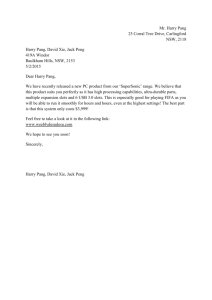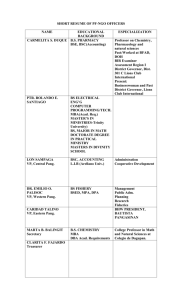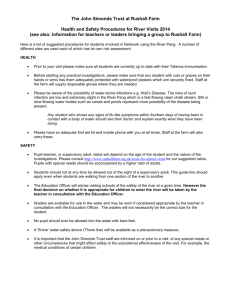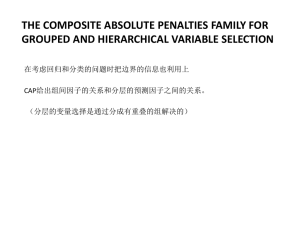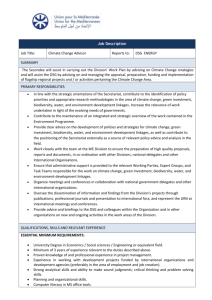Mining Patterns from Clinical Trial Annotated Joseph Benik , Guillermo Palma
advertisement
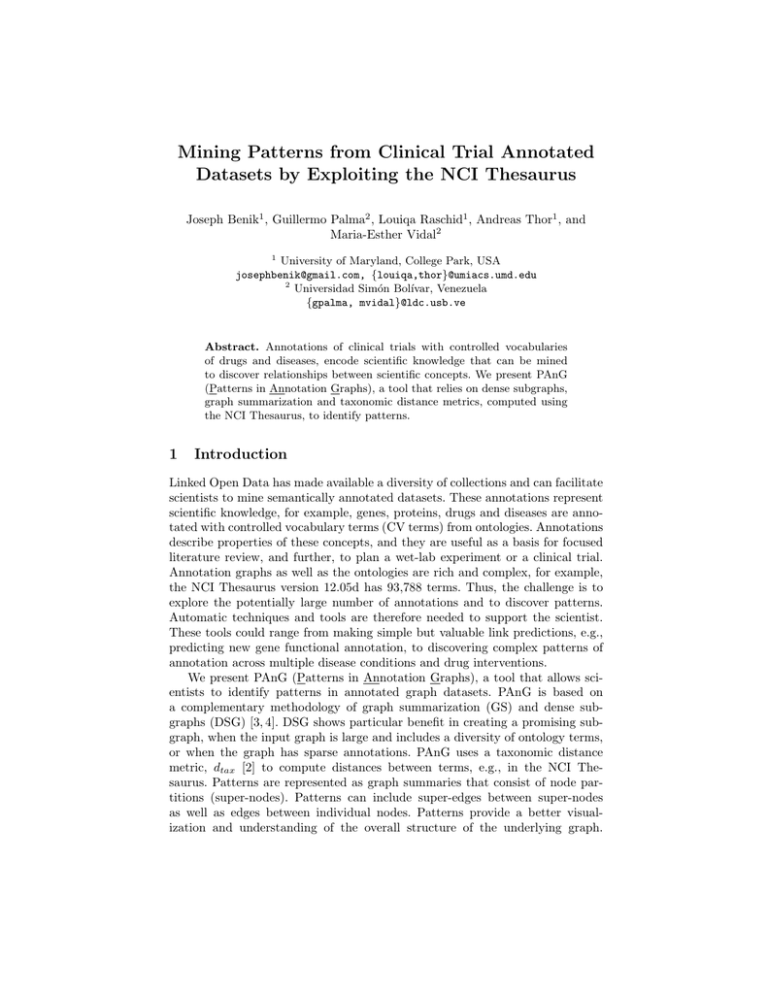
Mining Patterns from Clinical Trial Annotated
Datasets by Exploiting the NCI Thesaurus
Joseph Benik1 , Guillermo Palma2 , Louiqa Raschid1 , Andreas Thor1 , and
Maria-Esther Vidal2
1
University of Maryland, College Park, USA
josephbenik@gmail.com, {louiqa,thor}@umiacs.umd.edu
2
Universidad Simón Bolı́var, Venezuela
{gpalma, mvidal}@ldc.usb.ve
Abstract. Annotations of clinical trials with controlled vocabularies
of drugs and diseases, encode scientific knowledge that can be mined
to discover relationships between scientific concepts. We present PAnG
(Patterns in Annotation Graphs), a tool that relies on dense subgraphs,
graph summarization and taxonomic distance metrics, computed using
the NCI Thesaurus, to identify patterns.
1
Introduction
Linked Open Data has made available a diversity of collections and can facilitate
scientists to mine semantically annotated datasets. These annotations represent
scientific knowledge, for example, genes, proteins, drugs and diseases are annotated with controlled vocabulary terms (CV terms) from ontologies. Annotations
describe properties of these concepts, and they are useful as a basis for focused
literature review, and further, to plan a wet-lab experiment or a clinical trial.
Annotation graphs as well as the ontologies are rich and complex, for example,
the NCI Thesaurus version 12.05d has 93,788 terms. Thus, the challenge is to
explore the potentially large number of annotations and to discover patterns.
Automatic techniques and tools are therefore needed to support the scientist.
These tools could range from making simple but valuable link predictions, e.g.,
predicting new gene functional annotation, to discovering complex patterns of
annotation across multiple disease conditions and drug interventions.
We present PAnG (Patterns in Annotation Graphs), a tool that allows scientists to identify patterns in annotated graph datasets. PAnG is based on
a complementary methodology of graph summarization (GS) and dense subgraphs (DSG) [3, 4]. DSG shows particular benefit in creating a promising subgraph, when the input graph is large and includes a diversity of ontology terms,
or when the graph has sparse annotations. PAnG uses a taxonomic distance
metric, dtax [2] to compute distances between terms, e.g., in the NCI Thesaurus. Patterns are represented as graph summaries that consist of node partitions (super-nodes). Patterns can include super-edges between super-nodes
as well as edges between individual nodes. Patterns provide a better visualization and understanding of the overall structure of the underlying graph.
Fig. 1. The PAnG System Workflow.
Fig. 2. PAnG’s GUI for the LinkedCT dataset.
Further, the pattern captures semantic knowledge not only about individual
nodes and their connections, but also about groups of related nodes. LinkedCT
(LinkedCT.org) is a Linked Open Data dataset from the clinical trial site (ClinicalTrial.gov). Conditions represent diseases and are typically described using
the NCI Thesaurus. Interventions include a (unique) name, a description and a
type, e.g., a drug, device, procedure, etc. PAnG for LinkedCT.org is available at
http://pang.umiacs.umd.edu/iswc2012demo.
2
The PAnG System
Figure 1 illustrates the overall workflow of PAnG. The input is a tripartite annotated graph G, and the output is a graph summary. Our workflow consists of
two steps. The first step is optional and deals with the identification of dense
subgraphs, i.e., highly connected subgraphs of G that are (almost) cliques. The
Fig. 3. Graph Summary for Alemtuzumab. PAnG configuration: S12 (alemtuzumab),
DSG+GS, Triples Not Required, Distance between Condition: 0.5, Distance between
Intervention: 0.5, Allowing combining heterogenous nodes, Remove singletons.
goal is to identify interesting regions of the graph by extracting a relevant subgraph. Graph summarization transforms the graph into an equivalent compact
graph representation. Graph summaries are made up of the following elements:
(1) supernodes; (2) superedges; (3) deletion and addition edges (corrections).
Figure 2 shows the PAnG interface for the LinkedCT annotation graph dataset.
A scientist can search on conditions or interventions and create a subset of clinical trials. She can then choose the DSG option, with a threshold for dtax for
conditions or interventions or both. She can also skip the DSG option or choose
a DSG without a distance restriction. She can also require that the DSG option
favor the selection of triplets across the tri-partite graph, or favor the selection
of independent doublets across the two bi-partite graphs. Figure 3 presents a
possible summary graph. There are 10 supernodes; five supernodes cluster conditions, four supernodes cluster clinical trials and one supernode clusters the
two interventions cyclophosphamide, and Filgrastim. A superedge is a solid edge
and occurs between two supernodes. It represents that all nodes in both supernodes are fully connected, for example, the superedge between the supernode
with the condition Myelodysplastic Syndromes and the supernode of 4 clinical
trials. The summary reflects the basic pattern (structure) of the graph and is
accompanied by a list of corrections, i.e., deletions and additions, that express
differences between the graph and its simplified pattern. For example, a deletion
edge to a condition that occurs within a supernode indicates that the specific
condition was not studied in a particular clinical trial, whereas the conditions
within the supernode, without deletion edges, were studied. In Figure 3, the
condition Lymphoma (top left-hand supernode) was not studied in the clinical
trial NCT00004143 · · · (top middle supernode).
3
Demonstration of Use Cases
As of September 2011, LinkedCT contains 106,308 trials, 2.7 million entities and
over 25 million RDF triples. We demonstrate two use cases:
Single Drug: We commence with a single drug and create a dataset of all clinical trials associated with that drug, and all other conditions and interventions
associated with these trials. We use the taxonomic distance metric, dtax [1], and
the NCI Thesaurus version 12.05d to compute pairwise (condition-condition) or
(intervention-intervention) distance. Because, this is a poly-hierarchy, if there are
alternate paths, the shortest path is chosen. Three drugs Alemtuzumab, Getfinib,
and Verapamil are used to illustrate the effect of different configurations. For example, Getfinib treats certain types of cancers, e.g., breast or lung cancer. With
no DSG, PAnG cannot discern any patterns. If DSG+GS are chosen, with no
distance restriction and triples required, PAnG produces a very simple summary
of a supernode of clinical trials for Breast Cancer, another supernode for Lung
Cancer, with only Getfinib as the intervention, and one clinical trial covering both
cancers. However, with DSG+GS, no distance restriction, no triples required, a
different graph summary is generated. For example, with a distances threshold
of 0.3 for both conditions and interventions, Esophageal Cancer is related to a
supernode of Radiation Therapy, conventional surgery and neoadjuvant therapy;
this suggests that this disease is related to these three procedures, in addition
to treatments with Getfinib.
Drug Family: The NCI Thesaurus is used to explore drug families and their
properties. Starting with Alemtuzumab as an exemplar, we retrieve the intersection of Monoclonal antibodies and Antineoplastic agents. This creates a dataset
of 12 drugs: Alemtuzumab, Bevacizumab, Brentuximab vedotin, Cetuximab, Catumaxomab, Edrecolomab, Gemtuzumab, Ipilimumab, Ofatumumab, Panitumumab,
Rituximab, and Trastuzumab. We use the pairwise annotation similarity based on
the set of interventions associated with each drug to select interesting pairs of
drugs[2] and then further analyze using PAnG.
References
1. J. Benik, C. Chang, L. Raschid, M.-E. Vidal, G. Palma, and A. Thor. Finding cross
genome patterns in annotation graphs. In DILS, pages 21–36, 2012.
2. G. Palma, E. Haag, L. Raschid, A. Thor, and M.-E. Vidal. An Evaluation of Metrics
to Compute Concept Similarity Based on Evidence from Ontologies. Technical
Report, University of Maryland UMIACS, 2012.
3. B. Saha, A. Hoch, S. Khuller, L. Raschid, and X.-N. Zhang. Dense subgraphs with
restrictions and applications to gene annotation graphs. In Conference on Research
on Computational Molecular Biology (RECOMB), 2010.
4. A. Thor, P. Anderson, L. Raschid, S. Navlakha, B. Saha, S. Khuller, and X.-N.
Zhang. Link prediction for annotation graphs using graph summarization. In Proc.
of International Semantic Web Conference (ISWC), 2011.
